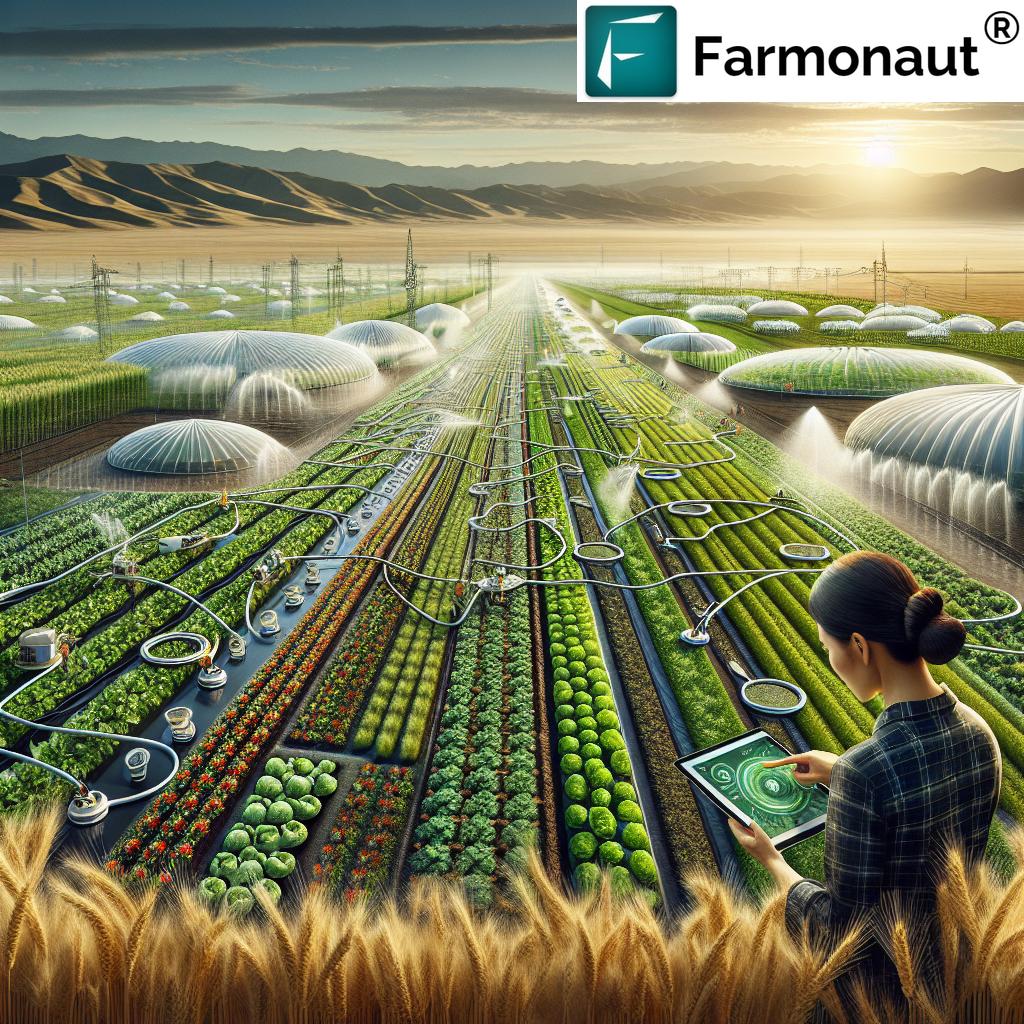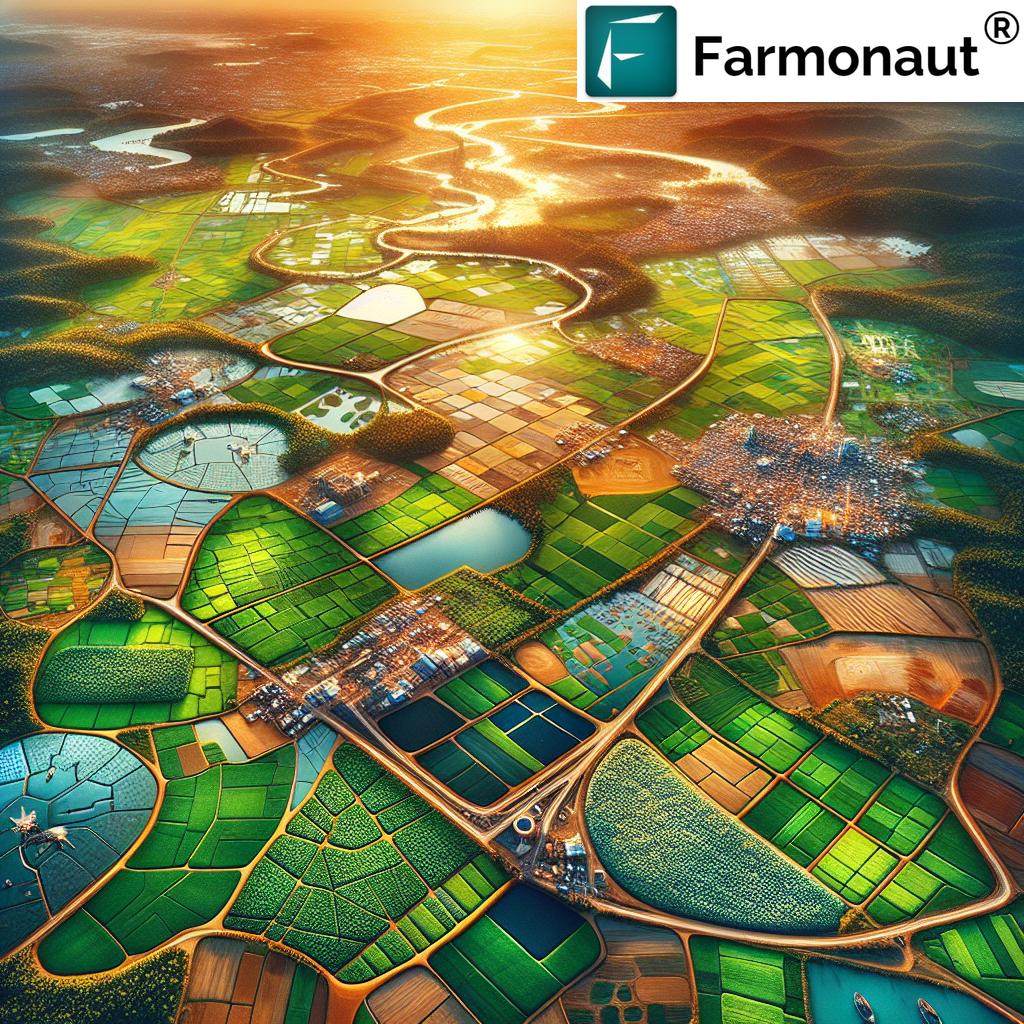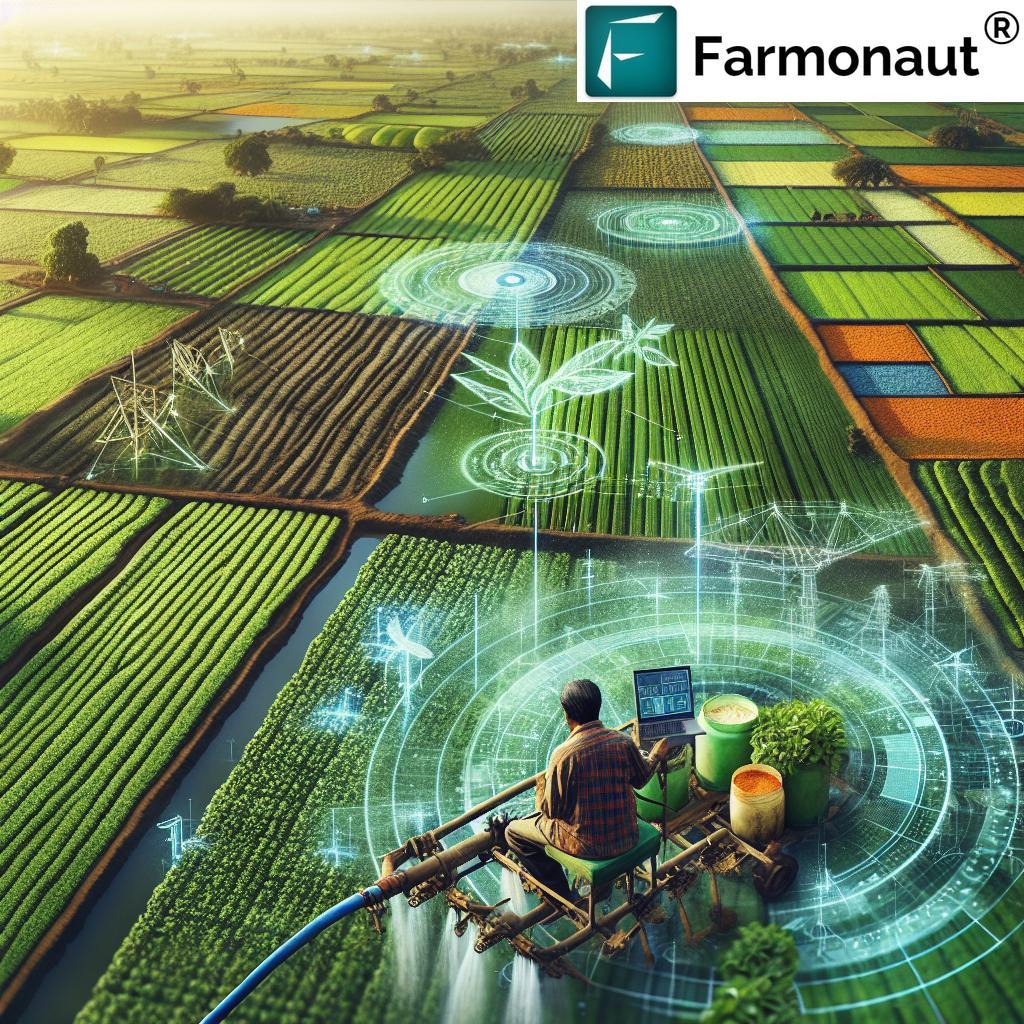Future Agriculture Technology in India: 2025 Trends – The Next Frontier in Smart Farming
- Introduction
- What is Agriculture 4.0? Defining the Next Frontier
- Key Trends in Future Agriculture Technology in India (2025)
- Comparative Trends Table: Future Agriculture Technology in India 2025
- Precision Farming & IoT in Indian Agriculture
- Drones and Satellite Imaging: A New Era For Crop Insights
- AI, Data Analytics, and Digital Platforms
- Automation, Robotics, and Farm Mechanization
- Climate-Resilient & Sustainable Technologies
- Farmonaut’s Role in the Future of Agriculture Technology in India
- Benefits for Indian Farmers: Productivity, Sustainability, and Security
- Challenges in Adopting Future Agriculture Technology
- The Future of Agriculture Technology 2025 & Beyond
- Frequently Asked Questions (FAQ)
Introduction: The Revolutionizing Future of Agriculture Technology in India 2025
India’s agriculture sector, long recognized as the backbone of the national economy, is now experiencing a profound transformation driven by breakthrough technologies. As we approach 2025, future agriculture technology is rapidly changing the landscape of Indian farming, promising unparalleled gains in productivity, sustainability, and farmer welfare.
This in-depth guide explores the critical trends, innovations, and challenges that will define the future of agriculture technology in India through to 2025 and beyond.
What is Agriculture 4.0? Defining the Next Frontier in Indian Farming
Agriculture 4.0 represents the next frontier in farming technology, where advanced technologies converge to create “smart farms.” Unlike prior revolutions that focused on mechanization, agriculture 4.0 emphasizes the integration of AI, IoT, data analytics, robotics, drones, satellite imaging, and precision agriculture tools.
The future of agriculture technology in India centers on data-driven, environmentally friendly, and efficient agricultural practices. By 2025, these systems will optimize resource use, minimize wastage, combat the challenges of climate change, and bolster food security for a growing population.
Key Trends in Future Agriculture Technology in India (2025)
- Precision farming using IoT and sensors: Real-time monitoring of soil health, water, and nutrients
- Drones and satellite imaging for advanced crop stress analysis, pest detection, and farm management
- Artificial Intelligence (AI) and machine learning for predictive analytics, climate pattern forecasts, and intelligent farm advisory
- Smart farm management platforms integrating cloud, digital advisory, and resource tracking for rural and large-scale applications
- Automation and robotics in planting, harvesting, weeding, and crop monitoring, alleviating labor constraints
- Blockchain for traceability and food security in supply chains
- Climate-resilient solutions: Drought-resistant seeds, vertical farms, and sustainable carbon footprint monitoring
Comparative Trends Table: Future Agriculture Technology in India 2025
| Key Agricultural Technologies | Estimated Adoption Rate by 2025 (%) | Projected Impact on Crop Yield (%) |
|---|---|---|
| AI-Powered Drones | 38% | Up to 20% increase |
| IoT-Based Soil Sensors | 49% | 15–24% increase |
| Precision Irrigation Systems | 43% | 13–18% improvement |
| Smart Farm Management Platforms | 55% | 18–28% higher efficiency |
| Satellite Crop Monitoring | 34% | 10–23% uplift |
| Climate-Resilient Seed Technology | 31% | 10–15% improvement |
| Blockchain Traceability Solutions | 26% | ~10% (reducing post-harvest loss and fraud) |
| Automation & Robotics (Harvesting, Weeding, Planting) | 22% | Up to 19% yield enhancement |
These estimates reveal robust prospects for future agriculture technology adoption accelerating productivity and sustainability by 2025, optimizing yields and resource management across India’s diverse agro-ecological regions.
Precision Farming & IoT in Indian Agriculture: The Data-Driven Future
The application of Internet of Things (IoT) and precision farming models stands at the heart of the future of agriculture technology in India 2025. With sensors embedded throughout fields, or even directly in the soil, Indian farmers can monitor moisture, temperature, nutrient levels, and other critical conditions in real time.
By connecting these devices to cloud platforms, valuable data is transmitted and analyzed. This enables AI models to generate recommendations for:
- Precise irrigation (reduces water wastage and costs, especially vital in water-scarce regions like Rajasthan, Gujarat, and Tamil Nadu)
- Targeted fertilizer and pesticide application
- Real-time disease and pest detection
- Automated, data-informed decision-making
This trend not only increases productivity and yields but also addresses sustainability concerns through environmentally friendly resource use. IoT in future agriculture technology also lowers input costs—a crucial consideration for smallholders across India’s rural landscape.
Access Farmonaut’s Web Platform and mobile apps for real-time satellite crop monitoring, soil analytics, and AI-driven farm advisory—empowering data-driven decisions on the ground!
Drones and Satellite Imaging: Revolutionizing Crop Insights & Surveillance
The future of agriculture technology 2025 will see drones (UAVs) and satellite imaging move from high-end research to mainstream adoption across Indian farms. Here’s how:
- Drones equipped with multispectral cameras provide high-resolution aerial imaging for precise detection of crop stress, disease outbreaks, and pest infestations.
- Early intervention enabled by drones considerably reduces yield loss and input costs.
- Satellite data augments drone insights, supporting large-scale surveillance and crop health monitoring even in geographically dispersed regions.
- The government and private initiatives are increasingly deploying this synergy to solve core agricultural challenges from weather prediction to precise resource allocation.
As drone use broadens, access to real-time, big data-driven insights on a farm’s micro-climate, pest patterns, and growth cycles will optimize management strategies, boost productivity, and support sustainable food security.
Looking to harness the power of satellite-driven insights and drone analytics? Explore Large-Scale Farm Management Solutions on Farmonaut—enabling agricultural enterprises to scale up surveillance, optimize fleets, and deploy resources efficiently across vast terrains.
Artificial Intelligence, Analytics & the New Digital Farm
In the transformation towards agriculture 4.0, AI and big data analytics are defining the future agriculture technology landscape in India. AI-driven platforms and cloud-based advisory engines now process large volumes of agricultural data—including weather, soil, supply chain, and market signals.
- Predictive analytics: Machine learning models forecast weather trends, pest outbreaks, and optimal planting/harvest periods tailored to specific Indian agro-climatic zones.
- Personalized recommendations: AI platforms deliver context-specific, real-time advisory directly to farmers’ mobile devices—democratizing expert knowledge even in the most rural communities.
- Smart resource allocation: Analytics tools optimize irrigation, fertilizer, and pesticide use by integrating IoT sensor data with machine learning algorithms.
The widespread adoption of AI-driven advisory systems such as the Jeevn AI platform (by Farmonaut) is critical in the future of agriculture technology in India by 2025, narrowing knowledge gaps, reducing risks, and enhancing productivity, even for smallholder farmers.
Interested in integrating weather intelligence and predictive analytics right into your farm operations? Try Farmonaut’s Satellite & Weather API for real-time weather monitoring, satellite-based field data, and custom AI integrations. Developer documentation is available at API Developer Docs.
Automation, Robotics & Mechanization: The Future of Efficient Indian Farms
Envisioning the future of agriculture technology 2025 would be incomplete without the ongoing movement towards automation and robotics in Indian farming. Although mainstream adoption is limited by small landholdings and cost barriers, new models are emerging that offer:
- Autonomous tractors and harvesters for labour-intensive tasks, reducing dependency on seasonal labor
- Robotic seed drills automating precise sowing and planting
- Weeding robots using AI vision to sort crops from weeds, lowering chemical usage
- Automated post-harvest handling, reducing wastage and improving supply chain security
As mechanization and automation evolve, their impact on efficiency, yield enhancement, and overall farm management will intensify, overcoming rural labor shortages.
Worried about transparency and security in your agricultural supply chains? Discover Farmonaut’s product traceability tools—built on blockchain for supply chain authentication, fraud reduction, and real-time resource verification.
Climate-Resilient & Sustainable Technologies: Addressing Food Security Amid Climate Change
As India grapples with the challenges of climate change, climate-resilient agriculture technology promises to ensure food security amid extreme weather, resource constraints, and ecosystem imbalances. Core innovations embraced as part of the future of agriculture technology in India 2025 include:
- Drought-resistant and early maturing seed varieties for crops vulnerable to rainfall variability
- Vertical farming and controlled-environment agriculture, especially in urban settings
- Real-time carbon footprinting and environmental impact monitoring tools for sustainable practices
- Integrated pest and nutrient management using AI and IoT
- Enhanced soil health through regular remote diagnostics, aided by satellite imaging
These innovations bolster the sustainability and resilience of Indian agriculture—safeguarding farmer welfare and national food security well into the next decade.
Track and minimize your farm’s carbon emissions or optimize inputs for a climate-resilient future with Farmonaut’s Carbon Footprinting—a dedicated tool to assess and reduce your environmental impact.
Farmonaut: Pioneering Satellite, AI, and Blockchain Solutions for Agriculture Technology Future
At Farmonaut, we are dedicated to democratizing satellite-driven insights and AI solutions for agriculture, mining, infrastructure, defence, and allied industries. Our comprehensive platform seamlessly blends satellite imagery, AI, blockchain, and real-time analytics to empower farmers, businesses, and governments across India and the world.
- Our satellite-based crop health monitoring analyzes NDVI, soil conditions, and environmental indicators—enabling data-driven farm management at any scale.
- With Jeevn AI advisory, users receive real-time weather updates, personalized recommendations, and actionable strategies for maximizing crop yields and resource use.
- Blockchain traceability and carbon footprinting tools help businesses and farmers reduce fraud, increase transparency, and build sustainable supply chains—vital for future food security.
- Our fleet and resource management systems optimize logistics, improve safety, and enable efficient scaling of operations in agriculture and industry.
All these tools are accessible via our robust web and mobile platforms (available for Android and iOS), or directly via API integrations.
Designed for everyone—smallholders, agriculture businesses, and governments—our tools are not just cost-effective: they are designed for scalability, sustainability, and ease of access.
Subscription plans to suit every need:
Benefits for Indian Farmers: Productivity, Sustainability, and Security
Embracing the future agriculture technology revolution brings substantial benefits for the Indian farmer and the nation:
- Improved Crop Yields: Precision tools and real-time monitoring can consistently lift yields by 10–28% across staples and horticultural crops.
- Input Optimization: IoT and AI analytics drastically cut fertilizer, pesticide, and irrigation overuse, protecting profitability and the environment.
- Risk Protection: Smart warning systems for pests, disease, or extreme weather shield farmers from sudden losses.
- Better Market Access: Blockchain traceability and data transparency open new markets, guarantee product authenticity, and enable higher-value sales.
- Access to Finance: Satellite verification-based Crop Loan & Insurance solutions make financing and insurance more accessible and less risky.
- Sustainable Resource Use: Tools for real-time carbon footprinting, soil health, and weather trends align farm practices with global climate goals.
- Empowerment Through Data: Knowledge is now in every pocket—AI-based advisories via smartphones are rapidly bridging the rural-urban agri-tech divide.
Challenges in Adopting Future Agriculture Technology Across Rural India
While agriculture technology future promises great rewards, several challenges must be navigated thoughtfully to ensure equitable access and sustainable progress:
- Small, fragmented landholdings limit economies of scale for deploying IoT, automation, and high-precision machinery.
- Digital literacy and internet access vary significantly in rural India, hindering uptake of app-driven advisory and cloud-based analytics.
- Initial investment costs for sensors, drones, and advanced devices remain a concern, especially for marginal farmers without robust government or financial support.
- Interoperability and standardization: Integrating diverse platforms, AI models, and IoT devices demands robust standards and adaptive policies.
- Data privacy and security: Protecting sensitive farm and weather data is critical as digital agriculture scales up.
- Capacity building and training: Farmer education and hand-holding are essential to ensure informed, confident use of new technologies.
Overcoming these challenges will require continued investment, strong rural infrastructure development, accessible digital tools, and collaborative public-private innovation—areas where government initiatives (like Digital Agriculture Mission, Soil Health Cards, and Digital India) already play a foundational role.
The Future of Agriculture Technology 2025 & Beyond: Creating a Data-Driven, Sustainable India
The journey towards agriculture 4.0 the future of farming technology in India is just beginning.
By 2025, an ecosystem of interconnected data will dominate Indian farming. Smart sensors, drones, AI-driven analytics, and satellite tools will empower every farmer—from the smallest rural landholder to the largest agri-enterprise—to make informed decisions, enhance food security, and build climate-resilient livelihoods.
- Increased adoption of data-driven tools will push average productivity and crop yields to new highs.
- Environmental sustainability will take center stage, supported by digital carbon tracking, resource management, and supply chain transparency.
- Farmer empowerment through platforms, blockchain traceability, and expanded access to finance will help address long-standing inequities.
- Continued innovation—spearheaded by satellites, AI, and IoT—will keep Indian agriculture resilient amid global climate, population, and resource demands.
The future of agriculture technology in India is bright, sustainable, and accessible. It’s a data-driven revolution—and the time to embrace it is now.
Frequently Asked Questions (FAQ) on Future Agriculture Technology in India 2025
1. What is the main focus of future agriculture technology in India?
The main focus is on transforming agriculture through AI, IoT, drones, robotics, precision farming, satellite data, and digital platforms to increase productivity, food security, and sustainability by 2025 and beyond.
2. How will sensors and IoT devices benefit Indian farmers?
IoT devices and sensors enable real-time monitoring of soil health, moisture, nutrient levels, and environmental conditions. These insights optimize water, fertilizer, and pesticide use, reduce costs, improve yields, and boost sustainability—especially valuable in water-scarce or climate-vulnerable regions.
3. What role do drones and satellites play in Indian agriculture’s future?
Drones and satellite imaging provide aerial surveillance, early pest/disease detection, and crop stress monitoring. This enables precision agriculture at scale and helps mitigate risks posed by unpredictable weather and climate change.
4. Are AI-based advisory and analytics platforms accessible for small Indian farmers?
Yes; platforms like Farmonaut’s Jeevn AI deliver region-specific, real-time advice directly to mobile devices in local languages. Increased smartphone penetration and affordable subscription models are making AI-based tools accessible even to smallholders in rural India.
5. What are the biggest challenges for adopting future agriculture technology in India?
Challenges include fragmented landholdings, digital literacy gaps, infrastructure limitations, initial investment costs, and capacity building needs. Addressing these requires robust policy, training, and collaborative efforts.
6. How can farmers access satellite-driven solutions from Farmonaut?
Farmonaut’s solutions—including web and mobile apps as well as API integrations—provide satellite crop monitoring, AI-based advisory, traceability, and carbon footprinting for improved farm management, scalable to any operational size.
7. What is the projected adoption rate of AI-driven and IoT technologies in India by 2025?
By 2025, over 60% of Indian farms are projected to use AI-driven solutions for precision agriculture, with adoption rates for IoT-based soil sensors expected at 49%, and other technologies following close behind.
Stay ahead in smart agriculture—explore Farmonaut’s platform and join the data-driven revolution powering the future of Indian farming!











